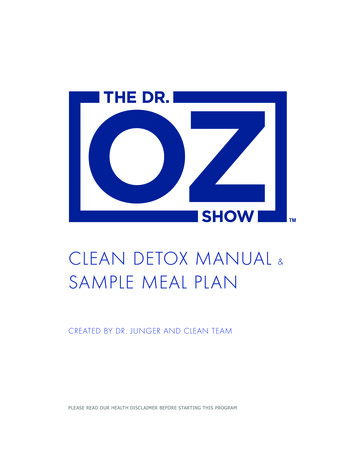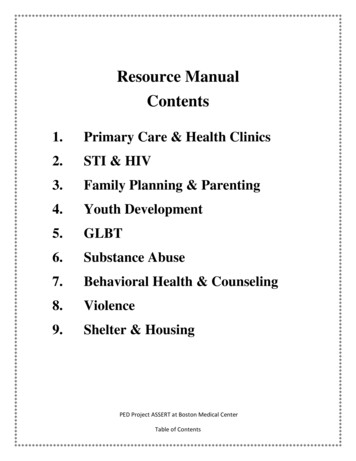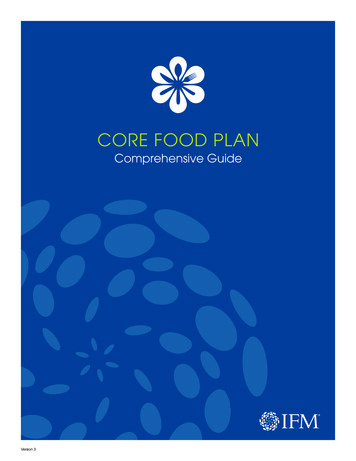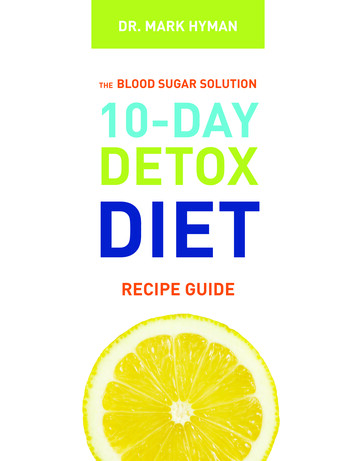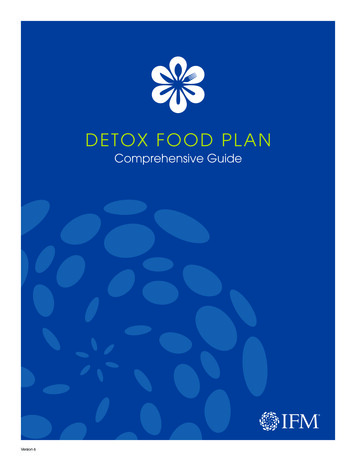
Transcription
DETOX FOOD PL ANComprehensive GuideVersion 6
Table of ContentsWhat is Detox?. 3Why Detox?. 5Food and Detox. 6Sequencing a DetoxificationProgram. 7Features of the Detox Food Plan. 8Touring through theDetox Food Plan. 12Personalizing Foods toDetox Pathways. 18Diet and Lifestyle Strategiesthat Influence Sex HormoneMetabolism. 22Frequently Asked Questions. 23Resources and Tools for Success. 27 2017 The Institute for Functional Medicine
What is Detox?The word “detox” has two common meanings: (1) to withdraw from the use of drugs or alcohol to which onehas developed an addiction, and (2) to describe the body’s physiologic process of rendering chemicals, compounds,hormones, and toxicants less harmful. The second definition is the one we use in Functional Medicine. This processis often referred to as “metabolic detoxification.” The organs of detoxification work efficiently as a whole to reducethe body burden or toxic load of chemicals. They include the liver, kidneys, large intestine, lymphatic system, andsweat glands.Scientists estimate that the average adult carries within her or his body at least 700 toxins and that anewborn’s body can contain over 200 toxins.In other words, there are well-defined metabolic pathways in the body that are responsible for converting toxinsinto chemical compounds, making it easy for the body to eliminate them (primarily through the urine or stools).Studies on how drugs are metabolized and cleared from the body have established a good understanding of thesedetoxification processes. Of course, metabolic detoxification is an ongoing process. Every day, the organs areworking to eliminate environmental contaminants that come in from toxic bacteria, pollutants, plasticizers, andheavy metals, to name a few. One of the most common exposures is toxic chemicals from agricultural production(pesticides, herbicides, and fertilizers). These exposures commonly occur through ingestion or inhalation of water,foods, and air and from time spent in the home or work environment. Sources of toxicants that can increase thebody burden include materials used in new construction, carpet chemicals that can off-gas into the air, paint,household cleaners, galvanic forces in the mouth that result from mixed metals in dental restorations, syntheticmaterials used in dental products, and even personal hygiene products applied to face, skin, and hair. Air pollutantsare found in industrial exposures, primary or second-hand smoke exposure, and auto exhaust. In other words,everyone is continually living amidst chemicals and toxicants in an increasingly toxic society, resulting in an everincreasing body burden or toxic load of chemicals.A person’s toxic body burden is a result of three main factors. First, there is the toxicant exposure we each mayhave received from both internal and external sources, as previously discussed. Second, each person’s geneticpredisposition to effectively produce detoxification enzymes for processing these compounds or substrates isunique and depends on familial influence. Lastly, the integration of proper nutrition and ongoing dietary ingestionof helpful detoxification nutrients or phytonutrients can impact the body’s capacity to appropriately reduce thepresence of toxicants and lower the body burden.IFMnDetox Food Plan Comprehensive Guide 2017 The Institute for Functional Medicine3
What is Detox?Toxic symptoms may occur when we get to our personal limit of accumulated toxins and are not able to clearthem quickly or efficiently enough. Medical researchers are recognizing more symptoms related to the buildup oftoxins, including obesity, type 2 diabetes, metabolic syndrome, cancer, fatigue, infertility, allergies, behavior and mooddisorders, and neurological conditions such as tremors, headaches, and cognitive difficulties, along with several otherdiseases like Parkinson’s and Alzheimer’s.The process of detoxification involves many steps. There may be reasons why the body isn’t particularly efficient aboutclearing toxins. These reasons can be situational, such as having an increased exposure to toxins, being constipatedand thus unable to excrete toxins in the stool, being deficient in specific nutrients, eating a nutrient-poor diet, beingunder stress, having a chronic disease, experiencing excessive inflammation, and not getting enough physical activityor restorative sleep. There may also be genetic reasons, such as having particularly slow enzymes that aren’t efficient inconverting toxins into compounds that can be excreted.The goal of a clinically-directed metabolic detoxification protocol is to provide nutritional support for facilitating thepathways involved in the processing and excretion of toxins. A detox program results in improved symptoms and anincreased sense of wellbeing for most individuals. Specifically, many who participate in a personalized detoxificationprogram describe improvement in pain and fatigue levels, enhanced cognitive function and moods, more effectiveand satisfying sleep cycles, and weight loss. The Detox Food Plan Comprehensive Guide provides specific food andnutrition suggestions to optimize the metabolic detoxification experience and lower the body burden. The guideoffers directions in how to sequence a healthy detox and wellness plan by providing tips on how to get started, what toeat, what to watch for, and how to provide the body with the right nutrients for longstanding, improved eliminationand detoxification.IFMnDetox Food Plan Comprehensive Guide 2017 The Institute for Functional Medicine4
Why Detox?Before a metabolic detox, symptoms and health complaints are typically assessed using a Medical SymptomsQuestionnaire (MSQ) to identify health concerns related to major body systems. If the MSQ score is higher thana certain number or certain clinical patterns become evident to the Functional Medicine practitioner, a metabolicdetoxification may be recommended. The practitioner may prescribe specific protocols and sequences of food plansfor beneficial clinical results. This guide details how a detox food plan is generally implemented.One of the biggest reasons to implement a detoxification program for a patient is a lack of energy. Fatigue is oneof the primary reasons people make changes to their lifestyle. Other reasons practitioners and patients might desirea metabolic detox include improved overall health, weight loss, and reduction in frequent or severe symptoms ofcertain diseases associated with toxicity.Recent studies indicate that weight gain may be more complicated than originally thought. No matter what thediet may be, when toxins are injected into animals, they have a greater chance of gaining weight. Many people areunaware of the weight connection with toxins, food triggers, and metabolic dysfunction.IFMnDetox Food Plan Comprehensive Guide 2017 The Institute for Functional Medicine5
Food and DetoxFood plays a role in all phases of detoxification (see graphic). The first step is to identify the toxic foods one iseating. By becoming aware of toxic foods and eating “clean,” many toxins can be eliminated, reducing the degreeof body burden. The remaining steps have to do with how the body metabolizes toxins, with the bulk of thoseprocesses occurring in the liver (phase I, phase II). Once the liver has transformed these toxins into water-solublemetabolites, they are ready for excretion by the kidneys, intestines, and skin.Food Plays a Role in All Phases of FMnDetox Food Plan Comprehensive GuidePhaseISupportPhaseIProtection 2017 The Institute for Functional Medicine6
Sequencing a Detoxification ProgramWhen many Functional Medicine practitioners think about detox, they think in terms of an elimination diet:having their patients temporarily eliminate from their diets major food triggers and allergens, such as glutencontaining foods, dairy, eggs, shellfish, soy, corn, and peanuts. Such an elimination diet is a short-term food plan,typically followed for around 3-4 weeks, as a first-step strategy to identify food triggers and develop better awarenessof the body’s reactions to particular foods while reducing the immune response to food. Often such a food planis used along with a gut restoration or healing program in patients who may present with the consequences ofintestinal permeability, sometimes referred to as a “leaky gut.” When used in this stage of healing, an assessmentof digestive function is often also done through testing to identify sources of gut bacteria or pathogens that couldcontribute to the internal body burden (endotoxicity).While the Detox Food Plan reduces intake of common food triggers, making it similar to the Elimination Diet, itfocuses on long-term nutritional support of the major body systems involved with detoxification, such as the gutand liver. It places a stronger emphasis on eating clean foods for life, reducing food contact with plastics or otherpotential contaminating elements, and eating organic foods when possible. Additionally, a metabolic detox planmay involve more rigorous nutritional intervention with medical food powders and dietary supplements, and evenfasting from food or eating only specific foods on certain days to further drive or amplify the effectiveness of thedetoxification system.One of the most important aspects in either a short-termelimination diet or the long-term Detox Food Plan is the emphasison consistent intake of foods that help optimize function of theprimary organs of elimination and reduce unhealthy stimulation ofthe immune system. The gut needs to work efficiently so that it canprovide one to two healthy, well-formed bowel movements daily.Without movement of the bowels, excretion of toxins is limited(as most of them exit in stool). Additionally, many of the toxinsprocessed by the liver are released through the bile and get excretedin the stool. Some of these converted toxins can be eliminatedthrough urine, too, which is why proper hydration goes hand-inhand with optimal detoxification. Adequate consumption of dietaryfiber—which means consuming more than 35 grams of fiberdaily—will aid elimination of stool and endotoxins.The Detox Food Plan, more than any other food plan within the IFM Food Plan Suites, is designed to supportnot just the gut but the liver. The liver is the hub of detoxification processes. When the liver is neglected oroverburdened through increased toxic load or lack of nutrients, it can become congested and sluggish, resultingin greater toxicity and increased symptom frequency and severity. The goal of the Detox Food Plan is to create agut–liver axis of support while lowering the burden on the immune system and providing adequate nourishmentthrough foods and liquids.IFMnDetox Food Plan Comprehensive Guide 2017 The Institute for Functional Medicine7
Features of the Detox Food PlanThe Detox Food Plan:nThe Detox Food Plan reduces exposureto trigger foods that may be connected to health concerns. Manypeople with food sensitivities don’t realize how bad they feel, or thatparticular foods are the culprit, until the foods that trigger a reactionare removed from the diet. Food reactions are frequently overlooked asa contributor to chronic health issues. Some reactions are consideredto be food allergies, meaning they cause severe symptoms immediatelyafter a trigger food is eaten. Some reactions may be delayed by hoursor even days; this type of adverse food reaction is referred to as a foodsensitivity. Food sensitivities are usually the result of an imbalancein the gastrointestinal system that affects the immune system. Foodintolerances are reactions to certain food chemicals (e.g., lactose, MSG,histamines, etc.) that occur when a person is lacking an enzyme ornutrient, resulting in an inability to properly metabolize certain foods.Reduces food triggers:Removing the specific foods that cause adverse food reactions will allow the gut to heal,while simultaneously supporting detoxification pathways. Common food triggers areminimized or eliminated on the Detox Food Plan, while nutrient-dense foods are includedto support detoxification and gut health.After completion of an initial removal phase, a practitioner may suggest a personalizedfood reintroduction process for some patients. The goal is to expand the variety of healthyfoods available to an individual for daily intake, not to maintain a long-term restrictive diet.Reintroduction involves adding back one food at a time and observing whether that foodis associated with symptoms. Foods that continue to provoke symptoms (physical, mental,and emotional) are avoided until they no longer cause symptoms. Once the gut is healed,many foods that initially caused sensitivities may be reintroduced into a meal plan withoutsymptoms. In the later stage of food reintroduction, the goal is to diversify the diet foroptimal gut health. Eating the same handful of foods day after day does not provide thebody with an array of phytonutrients, which is important for overall health and is especiallyimportant for those who have gut permeability issues.nIFMSupports liver function. Proteinis a key nutrient that enables the liver to effectively processtoxins within the body. Specific amino acids (building blocks of protein) are required forcertain types of toxin clearance. Therefore, this food plan suggests high-quality protein as anessential cornerstone to ensure that detoxification processes are efficient and effective.nDetox Food Plan Comprehensive Guide 2017 The Institute for Functional Medicine8
Features of the Detox Food PlannRequires clean and organic foods. TheDetox Food Plan emphasizes stringent measures toreduce the intake of toxins of all kinds by encouraging the intake of organically grown, nongenetically modified foods; lean, grass-fed animal meats or wild-caught fish; minimally refined,cold-pressed oils; and by reducing exposure to canned or plastic-containing foods and liquids.nReduces toxic burden: Toxins are everywhere: in food, air, water, and even in personal careproducts. It is best to start a metabolic detoxification program by first removing toxicants fromone’s food and drink supply as much as possible. Buying organically grown food helps to ensurea minimal intake of pesticides, herbicides, and insecticides. Limiting ingestion of geneticallymodified organisms (GMOs) and heavy metals, all of which have been associated with disruptionto the endocrine system resulting in obesity and metabolic disturbances like diabetes, is alsorecommended.Tips for minimizing intake of harmful substances include:IFMnnChoosing lean meats over fatty animal foods, as pesticides concentrate in fatnBuying organically-grown animal products (e.g., meats and dairy)nPeeling off the skin or remove the outer layer of leaves of some produce(e.g., lettuce, cabbage)nRemoving surface pesticide residues, waxes, fungicides, and fertilizers by soaking the foodin a mild solution of additive-free soap (pure castile soap or biodegradable cleanser)nCutting away any damaged or bruised areas before preparing or eating foodnWashing produce before peeling it so dirt and contaminants aren’t transferred from theknife onto the fruit or vegetablenConsulting the current versions of the Environmental Working Group’s “Dirty Dozen”(foods that are high in pesticide residues) and “Clean 15” (foods that are typically low inpesticide residues) listsnAvoiding foods that contain preservatives such as BHT, BHA, benzoate, and sulfites;food colorings such as FD&C yellow #5, #6, etc.; or artificial sweeteners such as sucraloseand aspartamenLimiting exposure to canned foods (e.g., meat, fish) and plastic bottles/containers of waterand high-acid foods due to the presence of toxins like bisphenol-A and other plasticizersthat have been shown to disrupt the endocrine gland functionnCooking with non-toxic pans, skillets, and pots that aren’t worn or scuffed so as tominimize any release of problematic compounds while cookingnEnsuring that drinking and cooking water is filteredDetox Food Plan Comprehensive Guide 2017 The Institute for Functional Medicine9
Features of the Detox Food PlannEnzymes involved in detoxification (phase I, phase II) within theliver are well recognized. Once enzyme imbalances are assessed, food and/or nutritional supplementscan be tailored to support, modulate, induce, or inhibit these enzymes to optimize detoxificationin the body. Imbalances between phase I and phase II detoxification can cause accumulation oroverproduction of toxic intermediate metabolites.Provides targeted antioxidants:Supports nutrient-dependent pathways: Thisfood plan is rich in plant foods that are essential in allstages of detoxification, especially those involved in processes occurring in the gut, liver, and kidneys.Phytonutrients are important for cell functions relating to reduction of toxins. Phytonutrients alsoplay an active role in improving the stress response and reducing inflammation. Plant foods tend toreduce net dietary acid load and enhance greater body alkalinization, which is helpful for kidneyexcretion of toxins. Key antioxidants help protect the body and support biotransformation of thesemetabolites. Whether or not the specific genetic variability of these enzymes is known, the food planis designed to include foods that support the processes involved in liver biotransformation of toxins.After the liver converts toxins into intermediatemetabolites, key antioxidants are required to protect the body from these processed compounds.Effective excretion through the stool and urine is a focus for this plan and is assured throughintegrating high-fiber foods and adequate liquids to ensure healthy elimination of transformedtoxins.nEncourages healthy elimination of toxins:nBalances hormone metabolism: When the toxin load is reduced and whole foods that support theliver and gut are increased, hormones can come into proper balance. Targeted hormone-balancingfoods are featured in this plan for those who require such support. Endocrine-disrupting compoundscan also interfere with proper hormone signaling; foods that improve detoxification have an impacton hormone receptivity.IFMnDetox Food Plan Comprehensive Guide 2017 The Institute for Functional Medicine10
Features of the Detox Food PlanD PL AN FEOOFATXUROTESEDRequirtsresand O Clerga annFoods iccesduRe BurdenxicTospopSu unctionrFeLivNNECTIONINFO RM ATIONP roTa vid esA n rg e tedti ox ida n tsCOesnc eBalaonH o r m li s mboM etaE N E R GYReduceFoodTrig sgerMEDICINEEHe n cr ts entalt ouraohygS u p p pendElim esofination Nutrient-De ysToxwahinstaPIFMnDetox Food Plan Comprehensive Guide 2017 The Institute for Functional Medicine11
Touring Through the Detox Food PlanThe Detox Food Plan is an advanced dietary application of specific foods used to improve detoxification function,provided in a list divided into several categories representing macronutrient levels (protein, fats, and carbohydrates)and smaller categories to guide you toward balanced diversity. The Detox Food Plan lists preferred foods toincorporate within a balanced daily diet to improve detox function. Certain foods are highlighted because they areconsidered to be Therapeutic Foods (explained below). The healthcare provider may give alternate suggestions thatare personalized to specific medical needs and may include a calorie target or guidance on the specific amount offood to consume.VEGETABLES Non-starchyDetox Food PlanCarbsServings/dayBrassicales ( i.e., Cruciferous)PROTEINSProteinsServings/dayLean, free-range, grass-fed, organically grownanimal protein; non-GMO, organic plant protein;and wild-caught, low-mercury fish. Avoidcanned meats.Animal Proteins:Plant Protein:Egg–1 or 2 egg whitesFish: Anchovy,halibut, herring,mackerel, rainbowtrout, sablefish,salmon, sardines,tuna (albacore,bluefin), etc.–1 ozMeat: Beef, buffalo,elk, lamb, venison,other wild game–1 ozPoultry (skinless):Chicken, Cornishhen, duck, pheasant,turkey–1 ozTofu (firm/extrafirm)–1½-2 ozTofu (soft/silken)–3 ozTempeh –½ cSpirulina–2 TProtein Powder:Check label for# grams/scoop(1 protein serving 7g)Egg, hemp, pea,rice, soy proteinisolate, whey1 serving as listed 35–75 calories, 5–7 g protein, 3–5 gfat, 0–4 g carbsAverage protein serving is 3–4 oz (size of palm of hand).LEGUMESProteins/CarbsServings/dayOrganic, non-GMOBean soups–¾ cFlour, legume–¼ cBlack soybeansEdamame(cooked)–½ cDried peas, beans, orlentils (cooked)–½ c(cooked)–½ cGreen Peas(cooked)–½ cHummus or otherbean dips–⅓ cRefried beans,vegetarian–½ cFATS & OILSFats1 serving 110 calories, 15 g carbs, 7 g proteinServings/dayDAIRY ALTERNATIVESMinimally refined, cold-pressed, ed, organicKefir, coconut orsoy–4-6 ozYogurt, coconut orsoy (cultured)–4-6 ozMilk (homemadepreferred): Almond,coconut, flaxseed,hazelnut, hemp, nut,oat, soy–8 oz1 serving 50–100 calories, 12 g carbs, 7 g proteinNUTS & SEEDSProteins/FatsServings/dayUnsweetened, unsalted organicAlmonds–6Avocado–2 T or⅛ wholeCoconut milk,regular (canned)–1½ TCoconut milk, light(canned)–3 TOils, salad: Almond,avocado, canola,flaxseed, grapeseed,Ghee/clarifiedbutter–1 tsesame, sunflowerOils, cooking:Avocado, clarifiedbutter, coconut,grapeseed, olive(extra virgin),sesame–1 thempseed, olive(extra virgin),pumpkin seed,rice bran, safflower(high-oleic),(high-oleic),walnut–1 tOlives: Black, lowerBroccoliHorseradishBroccoli sproutsKohlrabiVEGETABLES StarchyBrussels sproutsRadishesServings/dayDetoxifying Leafy GreensBok choyChard/Swiss chardChervilCilantroEndiveEscaroleGreens: Beet,collard, dandelion,kale, mustard e nuts–1 TArtichokesCeleriac ��2 TPumpkin seeds–1 TBeets, cubedSesame seeds–1 TSoy nuts–2 TWalnut halves–4Notes: Nutritional amounts are based on average values for thevariety of foods within each food category.Dietary prescription is subject to the discretion of thehealth practitioner.LeeksBamboo shootsBean sproutsCarrotsCucumbersEggplantFennel 2016 The Institute for Functional MedicineSprouts, allOther Non-Starchy VegetablesFermentedVegetablesGreen beansJicamaLettuce, allMushroomsOkraPeppers, allSalsaSea vegetablesOrganic, non–GMO fruits, vegetables, herbsand spicesVersion 6CarbsUnsweetened, no sugar addedCoconut (dried)–3 THemp seeds–1 TMacadamias–2-31 serving 80 calories, 15 g carbsScallionsLiver & Kidney SupportApple–1 smApplesauce–½ cApricots–4Banana, med–½Blackberries–¾ cBlueberries–¾ cCherries, all–12Dried fruit(no sulfites)–2 TFigs–3Grapes: Purple,green–15Grapefruit–½ medKiwi–1 medMandarins–2 smMango–½ sm1 serving 60 calories, 15 g carbsGLUTEN-FREE GRAINSCarbsServings/dayUnsweetened, sprouted, organicAmaranth–¾ cBrown rice cakes–2Buckwheat/kasha–½ cCrackers (nut, seed,rice)–3-4Millet–¾ cOats: Rolled orsteel-cut–½ cQuinoa–½ cRice: Basmati, black,brown, purple, red,jasmine–⅓ cTeff–¾ c1 serving 75–110 calories, 15 g carbsAll grain servings are for cooked amounts.BEVERAGES, SPICES & CONDIMENTSDaikon radishesChia seeds–1 T1 serving 45 calories, 5 g fatCarbsPotato: Purple, red,sweet, yellow–½ medRoot vegetables:Parsnip, rutabaga–½ cServings/dayPecan halves–4Hazelnuts–5Acorn squash(cubed)–1 cButternut squash(cubed)–1 cPlantain–⅓ c or½ wholeOnionNut and seedbutters–½ TItems in blue indicate preferred therapeutic foods1 serving ½ c, 1 c raw greens 25 calories, 5 g carbsChivesCashews–6Sunflower seedkernels–1 tTomatoTomato juice–¾ cTurnipVegetable juice–¾ cWatercressFRUITSThiolsBrazil nuts–21 serving 45 calories, 5 g fatSnap peas/snow peasSpinachSquash: Delicata,pumpkin, spaghetti,yellow, zucchini, etc.Melon, all–1 cNectarine–1 smOrange–1 smPapaya–1 cPeach–1 smPear–1 smPineapple–¾ cPlums–2 smPomegranateseeds–½ cPrunes–3 medRaisins–2 TRaspberries–1 cRhubarb –½ cStrawberries–1¼ cTangerines–2 smFiltered water (withlemon or lime juice)Sparkling/mineralwaterFresh juiced fruits/vegetablesCoffeeKombucha (noadded sweeteners)Tea: Black,dandelion, green,herbal, etc.Herbs and Spices:Curry, dill, ginger,rosemary, turmeric,etc.Condiments:Lemon/lime juice,miso, mustard,tamari, vinegars,etc.– use sparingly,suggest 1 T or lessper servingItems in blue indicate preferred therapeutic foodsNotes: Nutritional amounts are based on average values for thevariety of foods within each food category.Dietary prescription is subject to the discretion of thehealth practitioner. 2016 The Institute for Functional MedicineProteinA Protein is an essential nutritional cornerstone of detoxification. One cannoteffectively detoxify without having the amino acids (building blocks of protein)to bind the transformed toxins in the liver so they can be carried out of the body.Additionally, regular protein helps stabilize blood sugar, which in turn minimizeshunger and cravings. When possible, it is ideal to include some protein in everymeal for ongoing support of liver detox. There are different sources of animaland vegetable protein to choose from on this food plan.Vegetarians can choosemiso, natto, tofu, tempeh, rice/hemp/pea protein powders, and plant-based burgeralternatives, while omnivores may add animal proteins such as eggs, fish, meat,poultry, and a vast array of protein powders. Shellfish are omitted from the DetoxFood Plan as they are often contaminated with high levels of toxic metals like mercury.Fish eaters should select from sources with the lowest amounts of mercury according tothe National Research Defense Council: anchovies, butterfish, catfish, croaker (Atlantic),flounder, haddock (Atlantic), hake, herring, mackerel (North Atlantic, chub), mullet,perch (ocean), pollock, salmon (fresh, wild), sardines, sole (Pacific), squid, tilapia, trout(freshwater), whitefish, and whiting. Fish associated with the highest mercury contentinclude bluefish, grouper, mackerel (Spanish, Gulf, King), marlin, orange roughy, sea bass(Chilean), shark, swordfish, tilefish, and tuna (canned albacore, yellowfin, bigeye, ahi).IFMnDetox Food Plan Comprehensive Guide 2017 The Institute for Functional Medicine12
Touring Through the Detox Food PlanAs with the other food categories, quality is of utmost importance. High-quality proteins of any kind are the bestchoice, including lean, grass-fed, organic, non-GMO sources. Remember to choose wild-caught fish, as farmedvarieties may contain hormones and toxic chemicals called polychlorinated biphenyls (PCBs).All proteins are essential for detoxification; however some contain specific compounds that play an important rolein the detoxification process.Therapeutic foods: Fish and soySpotlight on Soy Foods for DetoxSoy FoodsnnnnHigh methionine-containing food, making it important for methylationIsoflavones from soy influence phase I and phase II liver detoxificationIsoflavones help to modify estrogen metabolites toward the more protectiveestrogen metabolites (2-hydroxyestrogens) and away from the reactive,carcinogenic forms of estrogen (16-alpha-hydroxyestrogens)Choose non-GMO, organically-grown varieties of soy food products to preventintake of contaminantsLegumesLegumes are a perfect way to get quality dietary protein and fiber, both of whichhelp with detox in the liver and elimination from the body through the gut. Eatat least one serving of legumes every day in the form of soup, cooked beans, dips,or hummus. Legumes make a wonderful complement to brown rice or quinoa,or to a non-starchy vegetable. Try black (soy) beans in soup, add garbanzo beans(also called chickpeas) or kidney beans to a salad, or make a salad of 2–3 differentbeans with chopped onion and pepper. While high-protein foods are especiallytherapeutic for detoxification, black soybeans and edamame are highlighted inthis category for their protein, fiber, and isoflavone content.Therapeutic foods: Black soybeans and edamameDairy AlternativesDairy is not listed on this plan, because most commercially available dairy foods containtoxins and hormones. Additionally, dairy is a food trigger for many and a culprit ingastrointestinal symptoms related to leaky gut. There are several dairy alternatives on thisfood plan, mostly in the form of nut and grain milks. When buying dairy substitutes likecoconut, almond, hemp, oat, or rice milk, read the label carefully to ensure they containno added sweeteners. Note that coconut milk listed here refers to the boxed varietyrather than to its canned form because of the bisphenol A (toxic) lining that is found inmost cans. For soy, it is essential to select only organic soymilks to minimize toxin intakeand avoid GMOs.Soy products are highlighted as therapeutic foods for their high methionine and isoflavone content,as described above.Therapeutic foods: Organic soy milk, soy yogurt, and soy kefirIFMnDetox Food Plan Comprehensive Guide 2017 The Institute for Functional Medicine13
Touring Through the Detox Food PlanNuts & SeedsThe nuts and seeds category provides a variety of options for snack choices throughoutthe day. Nuts and seeds may also be sprinkled on top of salads, cereals, or vegetables.Compelling data support eating a handful of nuts each day to reduce chronic diseaserisk. While not required, it is recommended that at least 1 to 2 servings of nuts beeaten daily. Aim for a mixed blend of raw unsalted nuts (not peanuts) that aren’t heavilyroasted in oil. Try adding hemp seeds or ground flaxseed meal to a salad or a smoothie, and don’t forget about theease of using nut butters like tahini (sesame seed butter) drizzled over vegetables, almond butter on an apple slice, orcashew nut butter on a sliver of pear.All nuts, seeds, and their respective butters or pastes are considered to be therapeutic
Of course, metabolic detoxification is an ongoing process. Every day, the organs are working to eliminate environmental contaminants that come in from toxic bacteria, pollutants, plasticizers, and heavy metals, to name a few. One of the most common exposures is toxic chemicals from agricultural production .
